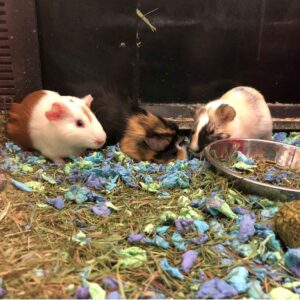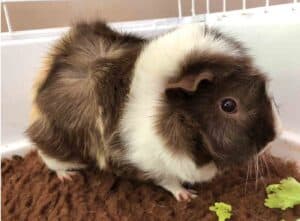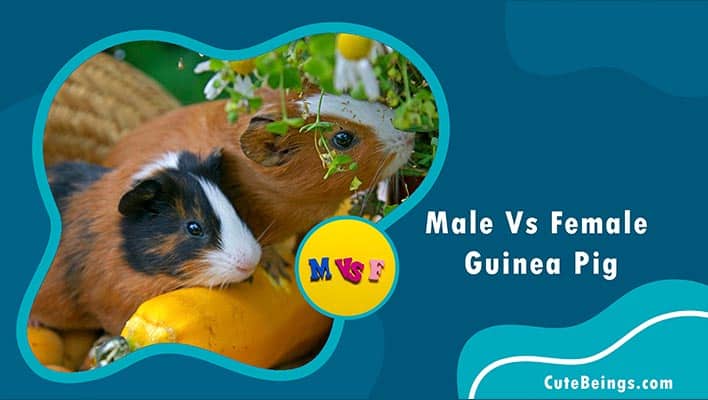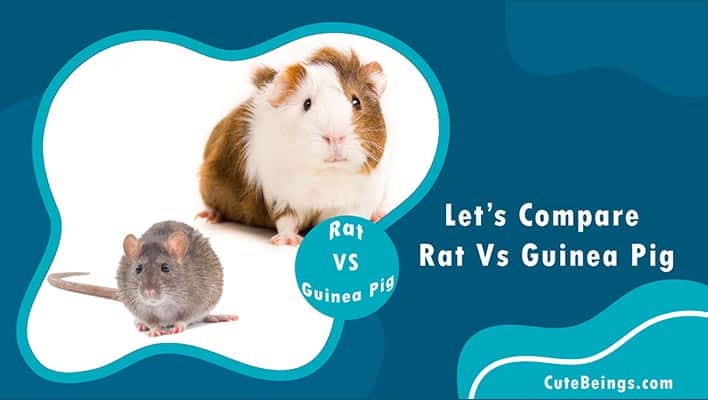Guinea pig urine is highly concentrated and has a strong distinguishing odor. You can find very concentrated mineral salts and these can build thick layers on guinea pig cage floor. These thick layers can be dispersed with vinegar. The capability to concentrate urine makes it probable to maintain moisture and essential minerals in the guinea pig’s body. So it is vital to select the cleanest, best and highly absorbent bedding material you can pay for. As a responsible pet owner you must choose the best for your guinea pig from various guinea pig bedding options so it can spend time in a secure and clean habitat.
Table of Contents
Why Is Bedding So Vital To Guinea Pigs?
The major and most significant purpose of rodent pet bedding should be soaking up injurious moisture from urine and feces. When bedding absorbs this harmful moisture, bacterial growth will slow down due to bedding’s supreme function. Also this reduces the creation of adverse gases such as carbon dioxide and ammonia and dangerous bacterial toxins.
In guinea pigs, the most established disease is the upper respiratory infection. Urinary tract infection is the second most found prevalent infection among cavies. These infections can be prevented by using suitable renowned guinea pig liners.
Usually guinea pigs have flimsy feet and a very susceptible respiratory system so always try to select the correct type of floor bedding to the guinea pig’s cage and it will improve your cavy’s health.
When you get a new home for your pets you need to cover the cage’s floor with some suitable bedding or flooring before you placing them in. The reason behind this is plastic floor in the cage is not suitable for your guinea pig. Because this plastic floor doesn’t support much for your guinea pig to sleep on or walk on as the surface is rough. It also doesn’t absorb your pet’s urine. So the first decision you have to make about guinea pig’s comfort is floor bedding.
Dry bedding needs to be used for the bottom of the cage so your pet can walk freely. As you need to change it weekly this will one of your frequent cost. Fortunately you don’t have to shop for the store bought items.
It will be hard at first, when you select bedding. As there are many choices for pet bedding, you will have to make some errors and trials to find out what suits best for your guinea pig. Remember to avoid these bedding materials such as cat litter, pine bedding, old shredded paper and glossy paper, cedar, wood shaving, woodchips, newspaper bedding, wood chips, corn cob and raw straw.
Avoid These When Preparing Guinea Pig Bedding
-
Beddings which are made from cedar shaving and pine shavings can be used as guinea pig odor control method because they have a lovely, fresh and natural odor. But using of these beddings is not healthy bedding option for guinea pigs. Most new pet owners choose cedar and pine shavings bedding as they are not expensive and available anywhere. Aromatic oils and phenols are included in cedar and pine and these chemicals could cause respiratory issues and liver failure. These chemicals are used to kill insects in shavings. Also these could cause allergic reactions to a small pet like guinea pig.
-
Avoid using sawdust near your pet as sawdust is too dusty. Sawdust can cause several health issues such as serious respiratory diseases and allergic reactions and also sawdust can damage and dry cavy’s eyes.
-
Do not use wood chips because they could cause eye damage to your guinea pig.
-
Cat litter can be used as an odor control because of its chemicals, but its rough, stone like feature can be harmful if ingested. While your guinea pig is playing, clumps can get raveled in your pet’s hair.
-
Corncob bedding does not absorb guinea pig’s urine or control odors. Also it can get moldy quicker than other beddings. Sometimes guinea pigs eat corncob when you place it as bedding. Corncob’s small round pellets can hurt your pet’s genital area or anal area and that can lead to impactions and infections. These small pellets can be mixed in the water and if ingested intestinal blockages can be caused as a result.
-
Raw straw will not control any order or absorb moisture when your pet defecates or urinates. It will be very hard for your pig to lie on as these solid stalks of straw don’t make a relaxed bed. Raw straw also can cause eye damages to your cavy’s sensitive eyes and damages to nose.
-
Most guinea pig owners choose paper bedding because it is not expensive, soft, absorbency is higher and controls order well. But the drawback is when paper bedding gets wet it stays wet. So the bedding gets dirty quickly. This makes a better environment for bacteria growth and mold. If your guinea pig spends more time in such dirty environment you pig could get a medical condition called as “bumblefoot”. If guinea pig eats this bedding material it could cause serious medical issues, even death as wet balls can be developed in pig’s tummy. The main issue in newspaper bedding is it contains ink and ink spreads when the newspaper is wet. This ink could be very risky to guinea pig.
-
Aspen shavings are also known as hardwood shavings. Aspen bedding does not contain harmful unstable oil. Bulk hardwood stove pellets are not expensive but check for any chemical additives and they are not fragrant as any other wood substrates. These wood pellets are great in absorbing and controls odor well but there is no much comfort as paper pellets. Hardwood shavings are less absorbent and contain dust. They are softer and messier than others as well. Because it is dusty they are not suitable for guinea pigs as even small amounts of dust particles are confirmed to be dangerous for your cavy.
-
Kiln-dried pine bedding has gone through special handling to reduce pine odor and volatile oil presence. But still pine is not good, no matter what you do you can’t take out all the smell and oils. Pine smell could be injurious to guinea pigs if there is not enough ventilation around the cage.
Consider Choosing These Bedding Types
Paper bedding or paper pellets
Paper bedding paper pellets are not expensive and paper products are outstanding bedding materials for all cavy types mainly long haired cavy breeds.

Simply you can think about paper based bedding to be a developed version of aspen bedding. Paper bedding does not contain any harmful odors and absorbency is higher than wood shavings. Paper bedding is also comfortable to guinea pig’s feet.
Normally paper bedding is better than wood shavings. But all the paper bedding products are not made evenly in quality. Some poor quality paper bedding could be worse than the best quality aspen bedding. The occurrence of small particles is very dangerous for guinea pig’s respiratory system.
If you are choosing paper bedding as your small pet bedding, do not just listen to marketing proposals, you need to check them by yourself to make sure the paper bedding you choose is in good quality.
Wood pulp fiber for bedding
Choosing wood pulp will be most popular decision many rich pet owners would make as wood pulp is fluffy and soft and guinea would love to walk on them. Guinea pigs also like to lie on wood pulp as it is very comfortable. As a material, wood pulp is good in absorbing and controls odor well but quite expensive than other materials.
Hay bedding

Hay bedding is natural and good in controlling odors and absorbing. But be sure to buy only chopped hay. The reason is hay has slight stick shape particles which are sharp and they could damage your guinea pig’s eyes.
Bamboo fiber
There are antibacterial and antimicrobial ingredients in this bedding type which fight with bacteria found in guinea pig bedding. Not only bamboo fiber flights with bacteria but also neutralize any bacterial growth.
This material absorbs water well so this is good at keeping your pet’s feet dry at most of the time. So it avoids the medical conditions such as bumblefoot.
Guinea pig Fleece bedding
This would be one of the most comfortable materials you will find for your guinea pig. It is a lovely, soft material which can provide a comfortable sleep for your cavies.

These days many guinea pig owners use more fabric than packaged pet bedding. Non pilling polyester fleece has become the main fabric that owners choose it is soft and absorb urine. Also this fabric will keep your pet warm.
Some purchase a fabric piece just to cover the floor of the cage. Others buy a big fabric piece to go up over the sides as well. When they are fixing the fleece they secure the sides by placing binder clips so the fleece doesn’t move. Placing just a fleece doesn’t make the cage comfortable for the guinea pigs and you need to choose a proper fleece liner as well. Efficiency can be increased in absorbing process by placing a fleece cage liner under the fleece.
There are various liner materials such as microfiber towels, chunky cotton towels, washable or disposable puppy pads, washable hospital pads, waterproof crib pads and thick liners of polyester quilt. You could also purchase some waterproof mattress padding from a fabric shop. You can place two different materials to maximize order control and absorbency.
Try this for a change, put folded cotton towels under the guinea pig fleece and hospital pads under the cotton towels as an absorbent layer. Your pet’s habitat will stay dry for a longer period.
Nowadays you can purchase convenient triple layered bedspreads which perfectly fit for coroplast trays of C & C cages. If you’re a guinea pig owner with new ideas you also can try the fitted fleece sheets specially designed for C & C cages and use your own cage liner for underneath the fleece. These guinea pig fleece bedding can be custom made for different cage sizes.
You would have to spend some good money at first if you are selecting guinea pig fleece bedding but mostly these bedding are reusable and washable so in the long run you would save more money than spending disposable bedding.
Before using for the first time, wash your fabric bedding three to four times then it will become more absorbent and soft. When you are cleaning remove any hair or feces by vacuuming or shaking up the fleece and then put them to washing machine with hot water, a little bit of vinegar and non fragrance detergent. Do not use fabric softener as it will decrease the absorbency. Then use tumble dry to dry up and remove it while the fabric is still slightly wet and let it dry naturally.
Many owners would recommend fabric bedding than sawdust or shredded paper bedding because less quantity of fragments would get into coat. Also fleece bedding is highly recommended for species with long hair as it would reduce the quantity of debris that could get trapped to their fur.
Here is a golden tip- when you purchase fabric purchase more than you actually need because hot water and tumble dry could shrink your fleece.
How Often You Should Consider Washing The Bedding?
Well this is mainly depends on you and with the number of guinea pigs you have. Always try to clean whenever you have a chance. Change your material at twice a week or more often as the situation demands. If you have few guinea pigs you might have to change your guinea pig bedding more often.
How To Select Suitable Bedding For Your Pet?
No matter which material you use but always be sure your material is dust free as much as possible. If your bedding has mold, dust or fine particles, they can be harmful to your pet as they could cause sneezing, wheezing and other respiratory issues.
Always give the priority to your pet’s comfort and length and further consider facts such as cost, convenience and cleanliness.

Hello, my name is Michelle and I’m a pet lover. For the past 12 years, I’ve been caring for pets. As a result of this, I decided to share my personal experience with you.




